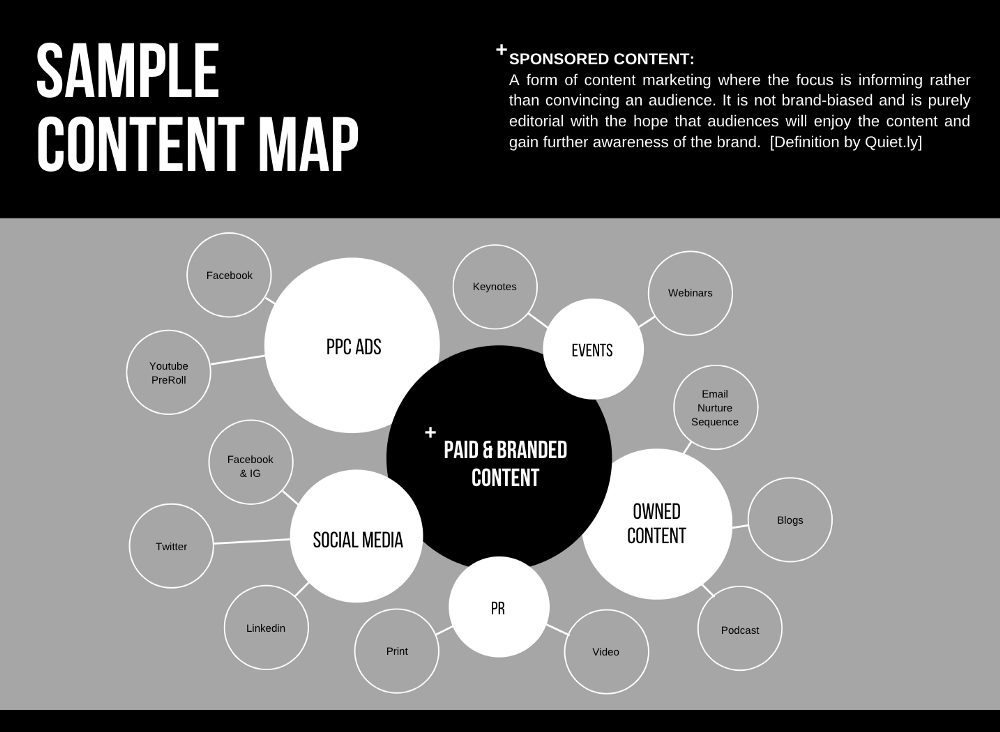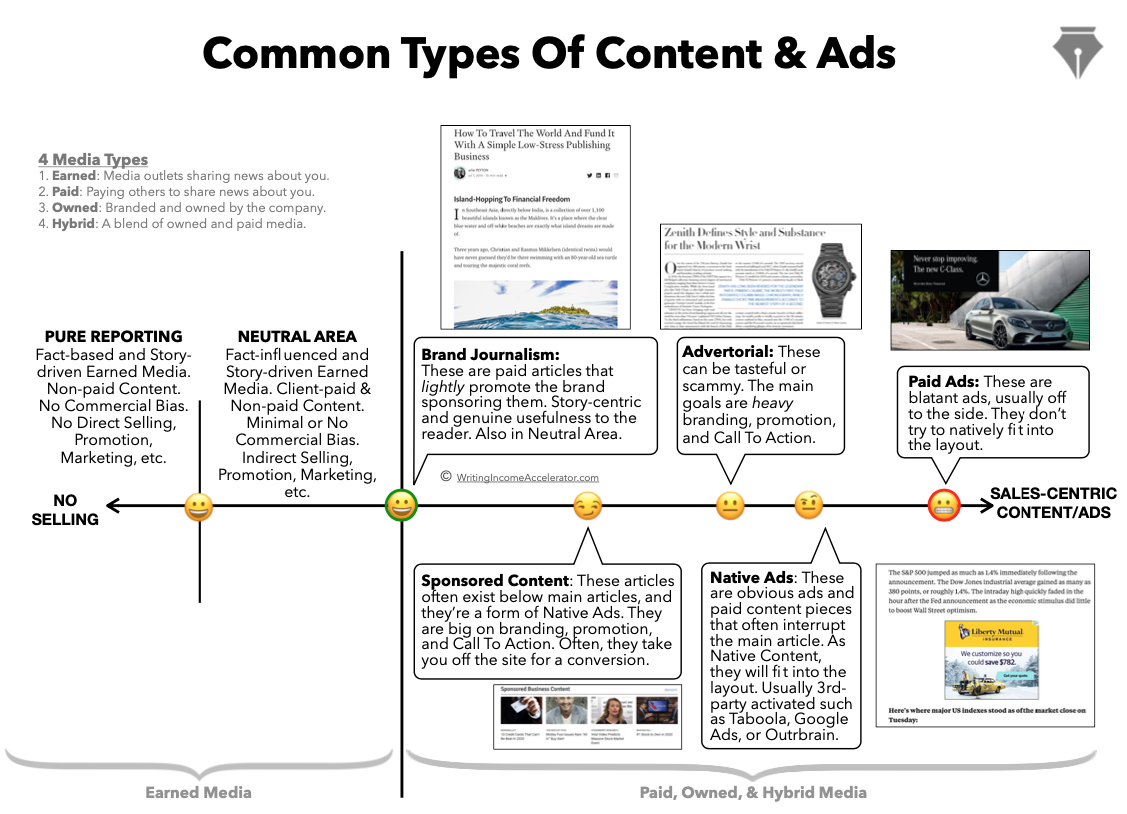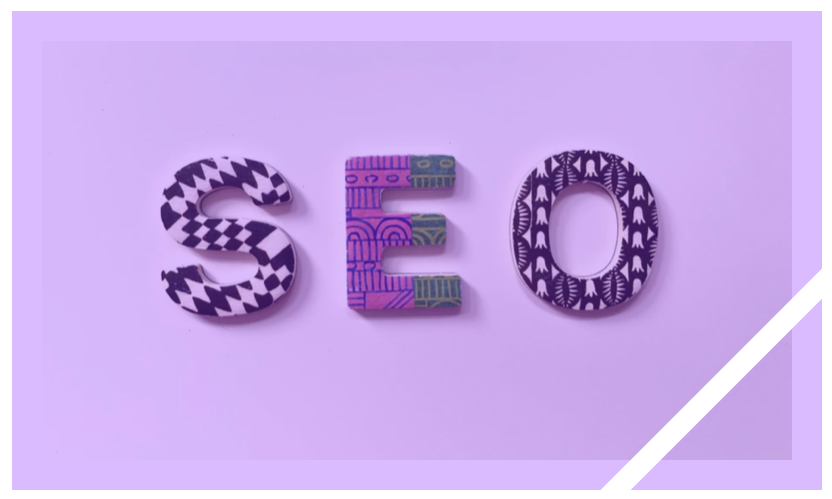Do companies now parallel or exceed mainstream media in producing great content? In light of all the fake news and the pressure for newspapers to produce clickbait-ish content or close its doors, it makes me really wonder.
We’ve seen countless companies like Apple, Microsoft, Oracle, Nissan, Mercedes, Wells Fargo, and Sequoia Capital explicitly hire professional writers to augment their marketing department. Many seasoned journalists from The Wall Street Journal, Wired, and The New York Times have traded in their newsroom digs to become content editors and brand journalists serving under CMOs.
The digital marketing landscape is changing before our very eyes. It’s not only more competitive than ever, but the very means of media communication is also changing. We saw this coming, but many companies are slow to adapt.
Twenty years ago, Seth Godin wrote Permission Marketing and predicted several maxims that brands are still struggling with today.
- “Marketing is a contest for people’s attention.”
- “People do not buy goods and services. They buy relations, stories, and magic.”
- “Marketing is no longer about the stuff that you make but about the stories you tell.”
He was right about everything, and in 2018 he was inducted into the prestigious Marketing Hall of Fame.
Now everyone understands what he was saying. A study done by OneSpot revealed that 92% of consumers want brands to make ads feel like a story. The best marketing is customer-centric and story-driven. In the past decade, we’ve seen marketing agencies that understand this create movements with their stories and transform regular customers into raving brand evangelists.

We’ve seen projects like the Dove Campaign for Real Beauty enjoy international fame. In 2004, this project brought 67 photographers together for three years. Their goal? To show how women from all walks of life can be comfortable and feel beautiful in their own skin. Prior to this campaign, Dove’s team conducted a survey and found that only 2% felt this way. All that changed after the campaign and Dove had increased their sales by $2B to prove it.
The odd thing about the Dove campaign was that they didn’t create blatant ads with all of their images per usual. It also couldn’t be classified as photojournalism. It was “branded content”, though no one called it that. This and other successful campaigns like it would make it easier for the evolution of brand journalism down the line because the storytelling was so powerful.
Today, to deliver brand messages we use platforms like Medium, Facebook, Instagram, and Snapchat that privilege their most effective feature which is actually called “stories”. And these stories come from countless sources. It’s just a matter of harnessing the best stories out there and branding them well. In effect, companies have been story curators. Echoing Godin’s words, Gary Vaynerchuk once tweeted:
Every single company out there, whether they know it or not, is a media company.
In fact, a few years ago I had Nike as a client and I was walking around their sprawling 300-acre campus in Beaverton, Oregon (aka, Nike World Headquarters). A peculiar black building caught my eye. On the outside, it just read “Nike Story” in bright white. I asked an executive what was in there and he said, “Oh, that’s part of the marketing department. Some people here say we’re a marketing firm that happens to sell shoes and stuff. ” All that stuff is valued at $34.8 billion dollars. It makes me wonder if that building was the birthplace of “woke marketing”, a movement that’s starting to blur branding and politics as we’ve seen with the Colin Kaepernick story.
Companies today that survive and thrive think like Nike. They put storytelling at the heart of every campaign. And what do these stories look like? We call it all content, for lack of a better word. It usually takes on the form of videos, infographics, podcasts, social media posts, email newsletters, and short blog posts.
However, if you really want to tell a story, you might need a bigger format. One format that is making a big impact in marketing is Brand Journalism.
What Is Brand Journalism?
Brand Journalism is the use of honest journalism as the framework for communicating brand-informed stories to the public.
You take the best techniques of journalism, focus on storytelling to carry the message, and then subtly associate all of it with a brand. Blend it all together and you’ve got yourself a perfect brand journalism cocktail that audiences are willing to sip from all day.
And here’s the recipe: It’s two parts creative journalism, one part storytelling, and garnished it with a sliver of branding. When you serve it up on an SEO platter to get seen online, it’s a powerful cocktail that satisfies both the brand client and the consumer.
If all of this is making you thirsty or hungry, it makes sense that the person who coined the term “brand journalism” was the former CMO of McDonalds, Larry Light. His marketing campaigns for the franchise were legendary. What he knew back in 2004 was that “no single ad tells the whole story”. Today, no one would argue that fact and that brand journalism is a great way to get those stories out there.
If there is a full story to be told, it needs space to breathe, time to unravel, and narratives to engage people. That’s a tall order for a Super Bowl ad or a Facebook post to fulfill.
All marketers see value in brand journalism which resides under the content marketing umbrella. The best campaigns make full use of the marketing matrix to deliver a diversity of brand exposure. However, content marketing is not perfect.

The problem with most content marketing (besides the term), is that it’s too aggressive. It’s too much about slick call-to-actions, robotic conversions, and endless optimizations.
What works is truly connecting with an audience. Though some content creations are actually interesting or funny, we all know content when it’s being shoved on us. This type of push-marketing or non-permission marketing was exactly what Godin was trying to condemn.
In contrast, brand journalism is reader-centric.
The brand journalist communicates any true story that will bring customers or prospects closer to the brand.
These stories often connect with people at the top or middle of the sales funnel, though some are further down the funnel and are ready to buy now. Far too many ads try to get the customer to buy something after very little exposure. It’s superficial and a bit annoying. The data supports this. A report by Demand Gen showed that 47% of buyers viewed 3–5 pieces of content before engaging with a sales rep.
In an interview with Contently, Godin goes on to say that “There are two kinds of native content: There’s content I want to read and content I don’t. If you’re putting content I don’t [want to read] in front of me, it doesn’t really matter how much you got paid for it — I’m probably not happy.”
Brand journalism works because most consumers don’t want to be marketed to, and when they do they have to somehow feel connected to the product or brand. That’s the genius of brand journalism. The right article can help consumers empower their own stories and aspirations. When you do that, you’ve got a sale. Win-win.
So while most content marketing rushes consumers to buy, the advantage of long-form articles is that they provide greater substance and connection. They grant you more time to hook readers, explain concepts, provide proof, and build a know-like-trust bridge to the sky.
As mentioned, a simple blog or ad can’t do that.
It Really Is About Stories
The neuroeconomist Dr. Paul J. Zak has done an extensive research to show that our brains are wired for story. When we come across a story, an uncontrollable neurochemical reaction takes place. Suddenly our thoughts are confronted with emotions that put a spin on interpreting things.
In a Harvard article, Dr. Zak revealed an interesting experiment. He hacked “the Oxytocin system to motivate people to engage in cooperative behaviors.” His team “found that character-driven stories do consistently cause oxytocin synthesis. Further, the amount of oxytocin released by the brain predicted how much people were willing to help others; for example, donating money to a charity associated with the narrative.”
Ethical brand journalists who employ storytelling and customer empathy are creating truly remarkable content. They tell authentic stories that might appeal to a reader’s motivations and desires. Stories might not be “magic” as Godin points out, but there is something special that happens to your brains and the right story can deeply influence human behavior.

These behavior-influencing stories translate quite nicely in the digital economy and the socialization of consumerism. As Annalisa Camarillo of NetApp has said, “I love [marketing today] because it’s now more about human behavior, it is about telling stories, it is about bringing journalistic value to content . . . it’s more truthful and transparent.”
The Choice Of Heroes In Brand Journalism
What’s interesting about brand journalism is the flexibility for writers to choose the appropriate protagonist of the story. With typical business articles, the brand is often the hero. Sometimes it comes across like saying, “Look how great my company is! Look what I’m doing now! Now go to our website and buy stuff!” Brand journalists do things differently.
The hero can be the customer, the product, or the brand.
In 1895, arguably the first successful use of brand journalism, John Deere published a customer-centric magazine called The Furrow. It consisted of helpful content just for farmers — whether you used their products or not. From almanac updates to analyzing plowing techniques, The Furrow was so useful that farmers couldn’t part with them. Today, that magazine now reaches over 2.3 million people across the world.
This was a brilliant move by John Deere. The magazine is owned media, so they have complete creative control. But rather than make it purely a catalog, they made it more valuable than a farmer’s mere wish-list of products. The company’s interests took a back seat to the reader’s interests. The farmer-hero set precedence.

I’ve done the same in my own writing too. Last year, I wrote an article about a client named Iman Gadzhi who wanted to do more work in philanthropy. The article really wasn’t about the products or services he made his fortune from. After succeeding in business, he donated $150,000 to build three schools in Nepal. He wanted to tell the story about how he was a high school dropout and what that meant. He thought public education needed a little reforming, but he was still a strong advocate of it. Building schools felt symbolic.
In December of 2019, Gadzhi took his entire staff to witness the schools being built. In his travel diary and my article, it was the little children of Nepal that were the true heroes of the story. (By the way, this article followed Medium and FTC Rules regarding paid content by properly disclosing that fact at the very top of the article.)
So, what did that strategic brand story do for the company? Not only did it connect with readers, that month they dramatically improved sales, email opt-ins, and client inquiries. Furthermore, read the comments. I’ve never seen anything like it. Readers and former clients were literally promoting his brand for him. If Gadzhi ever needed more social proof or reputation fodder, he now has twenty-nine testimonials in the comment section — no one anticipated this. You can’t buy that kind of loyalty. This article seemed to make everyone a hero.
The Difference Between Brand Journalism And Content Marketing
There are key differences between the goals of brand journalism and content marketing that companies like Cision have pointed out. Brand journalism seeks to build top-of-funnel brand awareness to new audiences. It sets the anchor point and context to follow-up.
With content marketing, the goal is more mechanical. The focus is on capturing and nurturing leads as quickly as possible. You can target the top and middle funnel prospects, but it can also be used with existing audiences.
The KPI’s for branded content includes impressions, audience size, time on site, page views, perception, comments, and share of voice. For content marketing, the KPI’s include lead generation, bounce rate, referrals, social sharing, and behavioral conversions.
So, the best-branded articles are often broad, long-form pieces that capture newer audiences. Think epic blog posts, ultimate guides, and comprehensive brand narratives. Sometimes this is referred to as Cornerstone or Pillar Content. Once that broad audience gets to know the brand, you can retarget them with niche topics and pieces to isolate prospects more likely to engage more with the company. This is how content marketing can assist Pillar Content. And in this regard, content marketing is perfect for mid-funnel lead scoring efforts. (That is, scoring documented prospects based on several weighted consumer behaviors.)

What Brand Journalism Looks Like
In the content marketing matrix, there are four main clusters of media: paid, earned, owned, and hybrid.
Paid media is designed to be persuasive. Earned media is designed to get publicity. And owned media is designed to increase brand equity and create loyalty. Brand journalism is a form of owned media, but it’s better described as a hybrid because it overlaps paid and earned media as well.
You can see this hybrid form in the work of Red Bull, the gold standard for what brand journalism can really achieve. The Red Bulletin is a company-owned media publication. It consists of a potpourri and chronology of branded content with the goal to entertain and inform. It’s only by the mere association to these stories that consumers can see any branding at all. Stories range from athlete interviews to in-depth guides on event locations that take a subjective point of view. The latter often takes on a cordial style much as Anthony Bordain did in his foodie series.

Another company that exemplifies brand journalism is Patagonia. Most of their pieces are short narratives focused on the outdoor lifestyle. The stories are rich and deeply personal. These are people and stories you can fall in love with. And if you’re a mountain biker, climber, any other kind of outdoor adventurer you can definitely relate to them. It’s the implied branded content that’s important here. It’s the brand in subtext. What you’ll see are people doing amazing things in the wild — and Patagonia is their outfitter.
You’d think that because the heavy marketing and promo is absent in these pieces that this kind of content doesn’t convert into sales. However countless case studies prove that this higher-level form of branding does exactly that: it turns prospects into buyers en masse. A study done by Curata showed that 74% of companies indicate content marketing is increasing their teams’ lead quality and quantity.
Part of the reason for this is that brand journalism is transparent. It’s not a one-sided ad. The content might be paid, but the stories are real. Also, it hooks audiences by aligning with their core values and interest. In addition to some crafty storytelling, brand journalism ties in our essential nature as exemplified by Maslow’s Hierarchy.
Article topics include things we value at our most basic level. In that narrative, the reader-hero is pushed along through that hierarchy from safety to belonging, and ultimately becomes empowered by the information acquired.

Okay, maybe this isn’t done in one article, but over time with multiple pieces, consumers begin to see how their values completely mesh with the brand’s values. And when you have that, you don’t really need to be persuaded much. This is why strategic long-form brand journalism and shorter content marketing pieces are a perfect mix to address audiences at various levels of brand affinity and buyer stages.
Why You Should Hire Brand Journalists
Here’s the thing about brand stories: every company has hundreds of stories to tell. The trick is to tell it in ways that matter to readers. Most companies understand this, as well as the diverse platforms they use to launch their brand messages. However, many are stuck in the pay-per-click mentality which is increasingly costing them more every year. The biggest downfall of PPC marketing is that when the advertising budget dries up, the online clicks stop too.
Great branded content leads with brand awareness, not conversions, and it often leaves a lasting impression. Epic guides can have pass-around rates much like magazines. Few consumers casually share ads with one another.
As a bonus, a long-form branded article has immense SEO value. If the content is remarkable, it continues to generate views and leads for the client many years after the post originally launched. Article SEO is the gift that keeps on giving, so the best pieces are well worth the article’s price tag.
And a single long-form branded article is just the beginning. What happens when you strategically string a few together to influence an entire nation?

Take a look at what brand journalism did for NASA. For example, what do most people remember about the early days of space exploration? It was destined to fail until NASA hired top-notch journalists to bring awareness to it. In his book Marketing The Moon, David Meerman Scott tells the story of how NASA leveraged journalists to help Americans begin to dream about their role in space. Suddenly rockets, moon landings, and space debris became a common part of the everyday talk in American society. The narrative was set.
It wasn’t an ad. It wasn’t a billboard. NASA created a series of stories that were delivered through journalism. This made Americans think more about space exploration. As the staff reporter Julian Scheer said:
We are going to get information out, and we are going to tell the truth.
Companies that have this same mentality get similar results with brand journalism. And as mentioned, some of the most innovative brand managers are starting to catch on.
In 2017, the research firm Technavio published an 83-page report on the state of content marketing. In it, they said by 2021 content marketing will be a $413B industry. This is why many freelance writers like myself rejoiced. Over the years, companies continue to pour more money into content marketing. Of this $413B market, tens of billions account for written content alone. This is content that either has to be produced in-house or contracted out to a freelance writer.

The exciting thing about it all is that writers get to work with brands and consumers on how to creatively tell their best stories. Some writers focus on brand journalism and other forms of content marketing. C-suite executives seek out writers like Nicolas Cole and his agency Digital Press for creating ghost-written content designed to get results.
Other writers like Kaleigh Moore specialize in working with SaaS and e-commerce companies. Kaleigh’s work has been featured in the most popular business magazines, and she continues to add value to business audiences everywhere.
Big media companies are fully on deck with brand journalism as well. You can hire them directly to get your story out there. For example, Forbes has the Brand Voice platform and Inc has the Inc Branded Content service. In the UK, there are services like The Telegraph’s Spark program for Branded Content. If you want more, IAB’s Branded Content Directory has over 60 publishers that companies can work with.
So, brands of the world, take advantage of the many opportunities in brand journalism. It’s here to stay and it’s one of the strongest ways to compel audiences to become loyal fans of your brand. It’s honest, engaging, and incredibly effective at getting more customers too. Plus, as Seth Godin says, “It’s easier to love a brand when the brand loves you back.”

